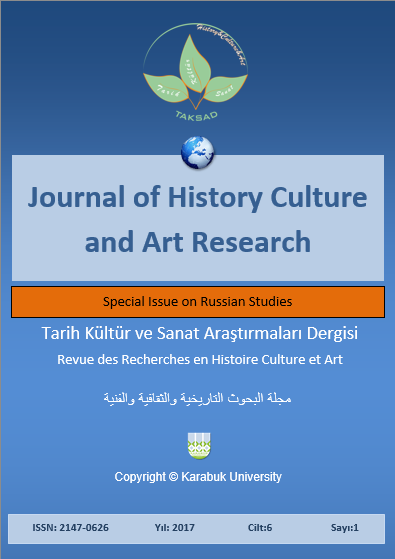Andrei Bely’s Literary Portraits in the Structure of Critical and Memoir Genre
DOI:
https://doi.org/10.7596/taksad.v6i5.1276Anahtar Kelimeler:
Criticism- The silver age- A. Bely- Memoirs- Genre of literary portrait.Özet
Despite the research boom of recent times and the increased interest in Andrei Bely's personality and creativity, which is reflected in numerous articles, monographs, dissertations, international scientific conferences about him, criticism and memoir remains the least studied part of the largest Russian symbolist creative legacy. Unfortunately, A. Bely's critical texts are not fully collected, we do not even have a complete idea of the volume of what he wrote. In order to comprehend the innovation of A. Bely's critical prose, it is necessary to update the research tools of the criticism itself. The correlation problem between A. Bely's creative method in the context of literary critical and memoir genres, the issues about the role and the uniqueness of portrait characteristics in different types of the discourse and the transformations of Bely's early poetics in late memoir and biography were not the subject of a special study, which determines the purpose and the tasks of the article. The performed analysis showed that the image of writers in the critical and memoir portraits is somewhat similar. This can be explained by the fact that Bely's memoir texts are the continuation of his early work. However, the publicistic nature of the criticism and the polemical origin in the memoir genre are weakened. The portrait in the structure of a memoir book is combined with the experience of the lived life and complicated by the synthesis of previous literary-critical interpretations and later evaluations.
Referanslar
Adamyan, E. I. (2011). Artistic Portrait and Memoirs in Prose by A. Bely. Dissertation for Candidate of Philology. Moscow.
Bely, A. (1990). The beginning of the century. Moscow: Union Theater of the USSR STD.
Bely, A. (1994). Criticism. Aesthetics. Theory of symbolism: in 2 volumes. V. 1. Moscow: Art.
Bely, A. (2012). Collected Works. Arabesques. The Book of Articles. Green Meadow. The Book of Articles. Moscow.
Bely, A. (2016). Diary of 1932. Literary heritage, 105. 912-988. Moscow: Nauka.
Fleishman, L. (1987). Bely's Memoirs. In John E. Malmstad (ed.), Andrei Bely: Spirit of Symbolism. Ithaca: CornellUniversity Press.
Kapinus, T. L. (2013). A. Bely's Critical Prose of 1902-1905: Aesthetics and Poetics. Dissertation for Candidate of Philology. Kharkiv.
Lavrov, A. V. (1989). Memoir trilogy and memoir genre by Andrei Bely. Bely A: At the turn of two centuries (pp. 375-401). Moscow: Dmitry Sechin.
Matich, O. (2007). Erotic Utopia: The Decadent Imagination in Russia’s Fin de Siecle. University of Wisconsin Press.
Mintz, Z. G. (1979). About some "neomythological" texts in the work of Russian symbolists. Scientist notes of Tatar State University, 459. Block collection III, Tartu, 76-120.
Paperno, I. & Grossman, J. D. (1994). Creating Life. The Aesthetic Utopia of Russian Modernism. Stanford: Calif Stanford University Press.
Shamina, V. (2016). Mystic motifs in silver age poetry and prose. Ghosts - or the (Nearly) Invisible: Spectral Phenomena in Literature and the Media, 9, 161-169
Spivak, M. (2005). East and/or West, Russia and/or Europe in the Later Works of Andrei Bely. 7th International World Congress for Central and East European Studies (ICCEES) “Europe – our common home?” (pp. 400-401). Berlin.
Spivak, M. (2005). The Fate of Andrei Bely's Archive. 7th International World Congress (ICCEES) “Europe – our common home?” Berlin.
İndir
Yayınlanmış
Nasıl Atıf Yapılır
Sayı
Bölüm
Lisans
Tarih Kültür ve Sanat Araştırmaları Dergisi'nde yayımlanan tüm çalışmalar Creative Commons 4.0 CC-BY lisansı ile lisanslanmıştır.
Bunları yapmakta özgürsünüz:
- Bu eseri her boyut ve formatta paylaşabilir — kopyalayabilir ve çoğaltabilirsiniz.
- Materyalden Adapte et — karıştır, aktar ve eserin üzerine inşa et
- her türlü amaç için, ticari amaç da dahil
Alttaki şartlar altında:
Atıf — uygun bilgiyi, lisansa linki, and ve değişiklik yapıldıysa değişiklik bilgisinivermelisiniz. Sizi veya kullanımınızı lisansörün onayladığı bilgisini içermemek kaydıyla, size uygun şekilde bu işlemleri gerçekleştirebilirsiniz.
AynıLisanslaPaylaş — Eğer materyali karıştırdınızsa, aktardınızsa ya da materyalin üzerine çalıştınızsa, ancak aynı lisans ile dağıtabilirsiniz.
- Ek sınırlamalar yoktur — Lisansın izin verdiği hakları başkaları üzerinde kanunlarla ya da teknolojiyikullanarak sınırlayamazsınız.







